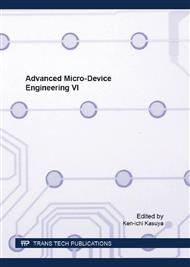[1]
P. Knauth, Solid State Ionics, 180 (2009) p.911–916.
Google Scholar
[2]
J. W. Fergus, Journal of Power Sources, 195 (2010) p.4554–4569.
Google Scholar
[3]
J. W. Fergus, Solid State Ionics, 227 (2012) pp.102-112.
Google Scholar
[4]
B. L. Ellis and L. F. Nazar, Current Opinion in Solid State and Materials Science, 16 (2012) p.168–177.
Google Scholar
[5]
M. Marcinek, J. Syzdek, M. Marczewski, M. Piszcz, L. Niedzicki, M. Kalita, A. Plewa-Marczewska, A. Bitner, P. Wieczorek, T. Trzeciak, M. Kasprzyk, P. Łężak, Z. Zukowska, A. Zalewska, W. Wieczorek, Solid State Ionics, 276 (2015) p.107–126.
DOI: 10.1016/j.ssi.2015.02.006
Google Scholar
[6]
E. I. Burmakin and G. Sh. Shekhtman, Russian J. Electrochem., 50, (2014) pp.496-499.
Google Scholar
[7]
W. G. Wyckoff, Crystal Structures Vol. 4, Second Edition, Interscience Publishers, (1968) pp.445-446.
Google Scholar
[8]
N. L. Organova, I. M. Marsii, I. V. Rozhdestvenskaya, T. I. Ivanova, N. D. Zakharov, V. V. Nasedkin, and S. B. Borisovskii, Crystallography Reports, 44 (1999) pp.770-775.
Google Scholar
[9]
E. Prince, G. Donnay, and R. F. Martin, American Mineralogist, 58, (1973) pp.500-507.
Google Scholar
[10]
H. Yamada, Y. Matsui, and E. Ito, Mineralogical Journal, 12, (1984) pp.29-34.
Google Scholar
[11]
M. Taylor and G. E. Brown Jr., Mark Taylor∗, · Gordon E. Brown Jr. Geochimica et Cosmochimica Acta, 43, (1979) pp.61-75.
DOI: 10.1016/0016-7037(79)90047-4
Google Scholar
[12]
W. L. Brown and I. Parson, Mineralogical Magazine, 53 (1989) pp.25-42.
Google Scholar
[13]
H. Behrens, W. Johannes, and H. Schmalzried, Physics and Chemistry of Minerals, 17, (1990) pp.62-78.
Google Scholar
[14]
L. Sanchez-Munoz, L. Nistor, G. V. Tendeloo, and J. Sanz, Journal of Electron Microscopy, 47 (1998) pp.17-28.
Google Scholar
[15]
A. Jones, M. S. Islam, M. Mortimer, and D. Palmer, Physics and Chemistry of Minerals, 31 (2004) pp.313-320.
Google Scholar
[16]
B. Roling, A. Happe, K. Funke, and M. D. Ingram, Physical Review Letters, 78 (1997) pp.2160-2163.
Google Scholar
[17]
B. Roling, Solid State Ionics, 105 (1998) pp.185-193.
Google Scholar
[18]
K. Funke, B. Roling, and M. Lange, Solid State Ionics, 105 (1998) pp.195-208.
Google Scholar
[19]
R. Belin, G. Taillades, A. Pradel, and M. Ribes, Solid State Ionics, 136-137 (2000) pp.1025-1029. Gordon E Brown Jr.
Google Scholar


